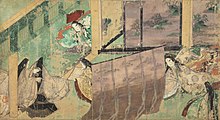Emakimono

Emakimono ( Japanese 絵 巻 物 ), or Emaki ( 絵 巻 ) for short , is a form of illustrated story that dates back to the Heian period in Japan . Emakimono combines text and images. It is drawn, painted or printed on a hand scroll. One can see emakimono along with the Egyptian hieroglyphs , medieval European church glass windows, and some pre-Columbian Central American manuscripts as an early form of sequential representation.
This art form developed in the 10th century and is influenced by cultural elements and scrolls that came to Japan along with Buddhism in the 6th century (see Buddhism in Japan ).
An emakimono is read from right to left, unrolling the roll with one hand and unrolling it with the other. In this way, only part of the story can be seen. You are expected to roll back the role at the end, just like a video after watching it.
The emakimono roll is tied with a string and stored individually or in a special, sometimes elaborately decorated box together with other rolls.
The most famous emaki is an illustration of the Genji Monogatari . It is based on the story of the lady-in-waiting Murasaki Shikibu, written around the year 1000 .
Web links
- Okada Yoshiyuki: "Emaki" . In: Encyclopedia of Shinto. Kokugaku-in , June 2, 2005 (English)
- Kokusai Nihon Bunka Kenkyū Center: High-resolution scans of Yōkai-Emaki
